Ladakh, which is situated in the northern part of India, has breathtaking sceneries as well as beautiful preserved culture, which includes several Buddhist monasteries that have earned wide recognition. The Buddhist monasteries in Ladakh are temple complexes that are for worship and also for the preservation and dissemination of cultural studies. Ladakh has many monasteries, well over a hundred and each of them is unique and has different historical and architectural aspects. Most of these Ladakh monasteries are of Tibetan Buddhism such as Gelugpa (Yellow Hat), Drukpa (Red Hat) and Others Nyingma.
Top 10 Ladakh Monasteries
The locations of the Ladakh monasteries are mostly on the hilltops or far away from the crowd which offers wonderful landscapes and also serves as a perfect restorative to both the onlookers and the monks. Let us look at 10 remarkable Buddhist monasteries in Ladakh.
1. Hemis Monastery
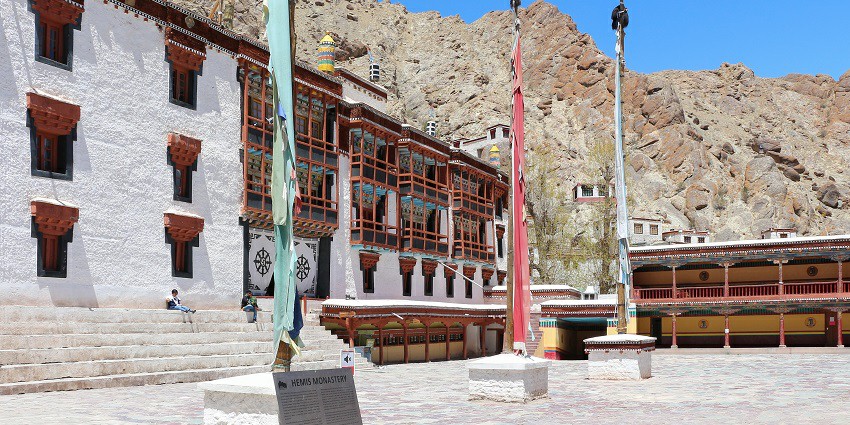
Photo: Bernard Gagnon / Wikipedia
Hemis Monastery, situated approximately 40 kilometres to the south of Leh, is the largest monastery in Ladakh and the most affluent among all the Buddhist monasteries. It was built in the 17th century during the reign of King Sengge Namgyal of Ladakh in the Drukpa region of Buddhism and dedicated to Guru Padmasambhava. This Ladakh monastery displays magnificent Tibetian architecture with detailed painted walls and crafted wood components and various structures including Dukhang or the assembly hall and Nyingma Lhakhang. One of the high points is the yearly Hemis Festival which is held in July and draws thousands of pursuers due to its flamboyant mask dances and cultural programmes.
Location: 40 km from Leh
Timings: 8 AM – 1 PM, 2 PM – 6 PM
Best Time To Visit: June to September; attend the Hemis Festival in July
Suggested Read: Hot Springs In Ladakh
2. Alchi Monastery
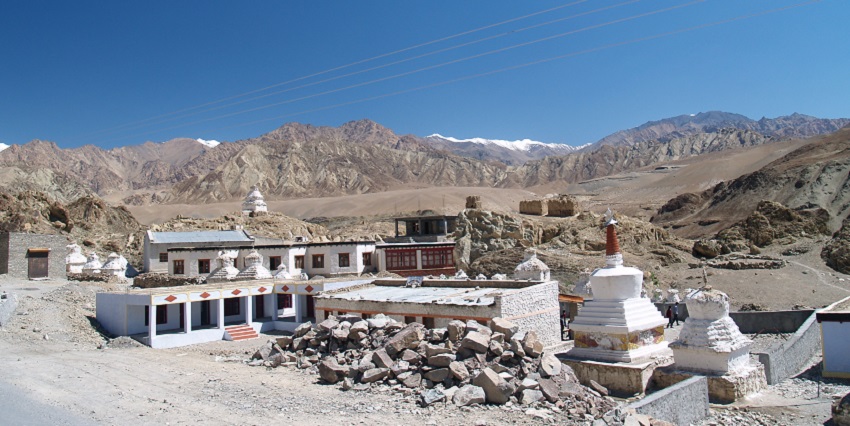
Photo: Steve Hicks / Wikipedia
The Alchi Monastery is situated some 70 km from Leh and set against the backdrop of beautiful Alchi village embodies one of the oldest and most prominent Buddhist monasteries of Ladakh. This monastery boasts mythical tales of having been built in the 11th century by translator Rinchen Zangpo. The murals in the monastery tend to be however more stylised with the influence of Indian paintings that sought to encode Buddhism in the local culture. The monastery complex consists of several temples which include the main temple (gTsug-lag-Khang), Manjushri Temple (Jam-dpal lHa-Khang), and Dukhang (assembly hall) which have very fine wood and ancient sculptures inside them.
Location: 70 km from Leh
Timings: 10 AM – 1 PM, 2 PM – 6 PM
Entry Fee: ₹25 (Indian), ₹50 (foreign)
Best Time To Visit: May to September
3. Lamayuru Monastery
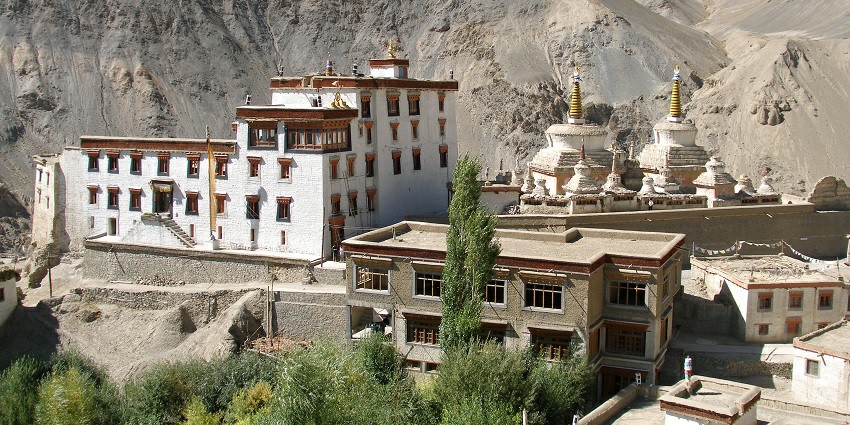
Photo: Vyacheslav Argenberg / Wikipedia
With a height of 3,510 metres above sea level, the Lamayuru Monastery which is situated at a distance of about 127 kilometres from Leh is one of the oldest of the Ladakhi monasteries. There were five buildings in the monastery complex but only one building survives to this day and accommodates about 150 monks. The main highlights are the Dukhang (assembly hall) whose walls are richly painted with murals and statues of many different gods and Naropa’s cave where the famous god spent his time in meditation. The monastery is best known for its Yuru Kabgyat festival when many more mask dances with a social pedagogy are performed.
Location: 127 km from Leh
Timings: 7 AM – 7 PM
Best Time To Visit: April to September; visit during the festival for cultural immersion
Suggested Read: Puga Valley In Ladakh
4. Thiksey Monastery
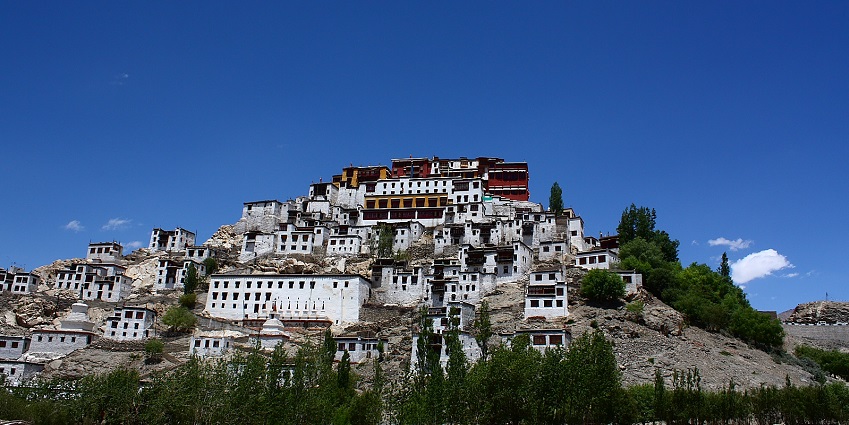
Thiksey Monastery, located about 19 kilometres to the southeast of Leh, is one of the biggest impressive monastic complexes that Ladakh has. It was built in the 15th century by Paldan Sherab, who was one of the followers of Je Tsongkhapa. It is made up of several temples among them is the main prayer hall or assembly hall known as Dukhang which is decorated with exquisite artworks and images such as the 15-metre Maitreya Buddha statue. Thiksey Monastery is also famous for the Gustor festival, which takes place during October or November.
Location: 19 km from Leh
Timings: 8 AM – 1 PM, 2 PM – 6 PM
Best Time To Visit: May to September; attend the Gustor Festival in October/November
5. Likir Monastery
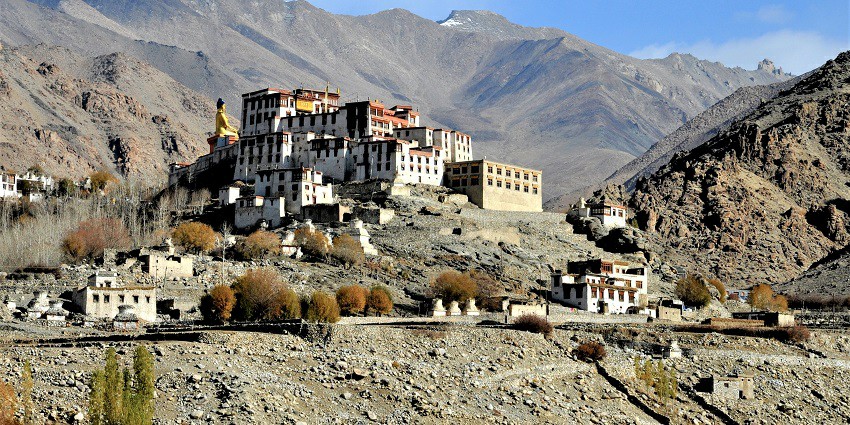
Photo: Prof Ranga Sai / Wikimedia Commons
Likir Monastery lies approximately 52 km west of Leh towards the Indus Valley and it is one of the major Buddhist monasteries in Ladakh which was built by Lama Duwang Chosje in the 11th century AD. The word ‘Likir’ means ‘the one that is encircled by naags’ and this relates to the mythical creation of the place as nagas are said to inhabit this area. Likir monastery is famous for its majestic architecture and peaceful surroundings located at an altitude of 3700m. One of the main attractions is the statue of Maitreya Buddha, which is 75 feet.
Location: 52 km from Leh
Timings: 7 AM – 7 PM
Best Time To Visit: May to September; attend the Dosmoche Festival in winter
Suggested Read: Adventure Sports In Ladakh
6. Diskit Monastery
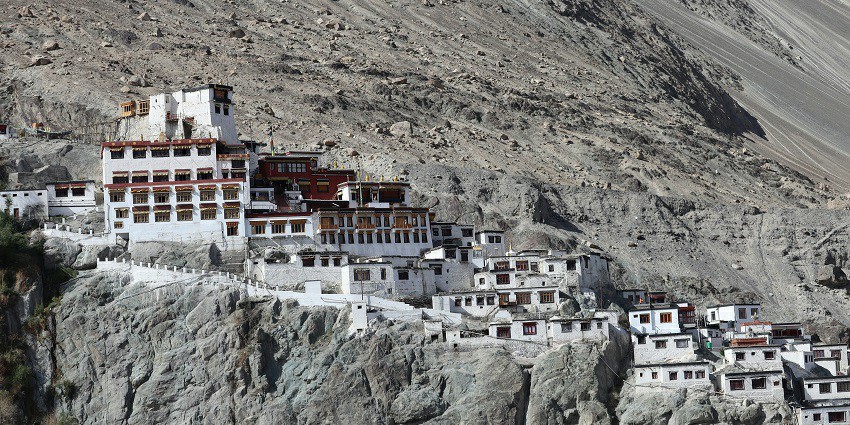
Photo: Rupendra Kumar / Unsplash
Diskit Monastery which is also known as Diskit Gompa happens to be the oldest and the largest Buddhist monastery in Nubra Valley, Ladakh. This monastery was built in the 14th century by Changzem Tserab Zangpo and is a Gelugpa sect monastery. The monastery is built on a rock hill dominating the view of the Shyok River and the Diskit village. Its most distinguishing attribute is the 106-foot statue of Maitreya Buddha which was blessed by the Dalai Lama. Inside, there is also the Dukhang (assembly hall), which contains some statues, a large drum used in ritual practices and a cover over organ pipes.
Location: Nubra Valley
Timings: 7 AM – 1 PM, 2 PM – 7 PM
Best Time To Visit: June to September; attend the Dosmoche Festival in December
7. Stakna Monastery
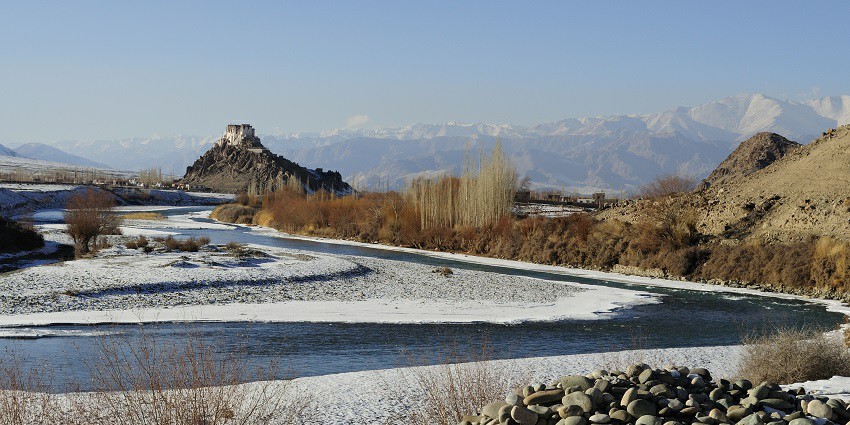
Photo: Vinod Krishna / Wikipedia
Stakna Monastery is about 25 km from Leh along the Indus River. It is a tranquil Buddhist establishment built around the 16th century by Chosje Jamyang Palkar, a saint from Bhutan. The name of the monastery has been derived from the unique geographical feature of the location where it is built, which is on a small hill that looks like a tiger’s nose. The key attractions comprise a 7-foot-tall chorten in the courtyard wrapped in silver with a statue of Buddha, Dukhaang ( an assembly hall) which has sakyamuni, tsephakmad and amchi painting embellishments, plus a couple of thangkas and paintings about Buddhist deities and their works.
Location: 25 km from Leh
Timings: Open daily from 6 AM – 6 PM
Entry Fee: Free
Best Time To Visit: May to September for pleasant weather and clear views
Suggested Read: Best Food In Leh
8. Phyang Monastery
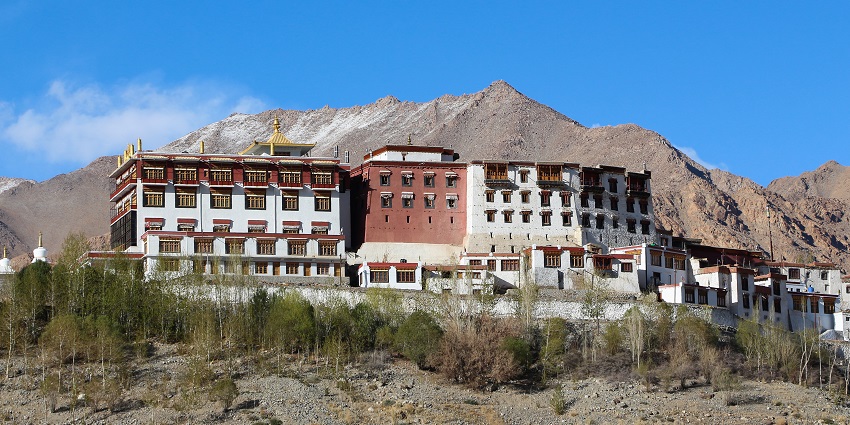
Photo: Bernard Gagnon / Wikipedia
The Phyang Monastery is located around 17 kilometres to the west of Leh. It is one of the main gompas of the Drikung Kagyu sect of Tibetan Buddhism. This monastery was also built in the 15th century. The monastery has an impressive traditional colour of white and ochre where a huge display of ancient murals, thangkas and a gallery of historical items such as Mongolian and Tibetan arms and armoury is kept. Phyang is also a significant place for Digung practices and organises the Phyang Tsedup Festival every year which is full of entertaining masked dance performances.
Location: 17 km from Leh
Timings: Open daily from 6 AM – 6 PM
Entry Fee: ₹30
Best Time To Visit: May to September for pleasant weather; attend the Phyang Tsedup Festival in July or August for cultural immersion
9. Chemrey Monastery
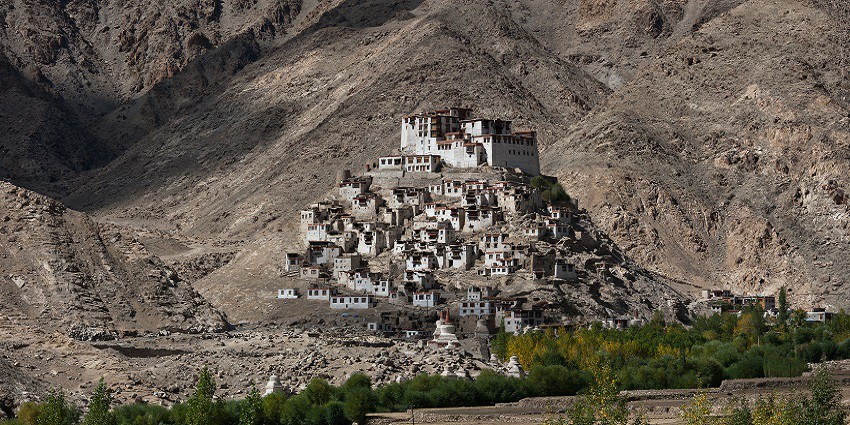
Chemrey Monastery, found nearly 40 kilometres away from Leh, is a great Buddhist institution founded in 1664 by Lama Tagsang Raschen in honour of King Sengge Namgyal of Ladakh. Situated on a hilltop, provides breathtaking views of the nearby area and is related to the Drukpa school of Tibetan Buddhism. The monastery is home to an astonishing one-floor-high statue of Guru Padmasambhava, as well as a 29-volume gold and silver script sacred text collection. Chemrey is famous as it is the site of the annual Chemrey Angchok festival which consists of various sacred dances and occurs in November.
Location: Approximately 40 km from Leh
Timings: Open daily from 7 AM – 6 PM
Best Time To Visit: June to October; attend the Chemrey Angchok festival in November for cultural experiences
Suggested Read: Trekking In Ladakh Zanskar
10. Spituk Monastery
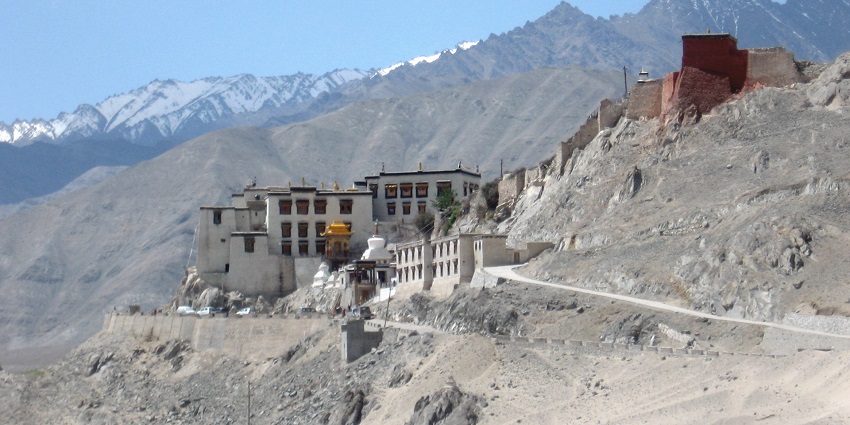
Photo: Redtigerxyz / Wikipedia
Spituk Monastery, or Spituk Gompa as it’s also called, is situated around 8 km east of Leh standing atop a hill facing the Indus Valley. It was founded in the 11th century by Od-de who was the elder brother of Lha Lama Changchub Od and follows the Gelugpa order of Tibetan Buddhism. The word “Spituk” is defined as “perfect” which alludes to its decisive place in the teaching and practice of Buddhism as well as the Lean Buddhist Cult. Among them is a statue of Kali, which can be seen only during the Gustor Festival held there every year.
Location: About 8 km from Leh
Timings: Open daily from 6 AM – 6 PM
Best Time To Visit: May to September; visit during the Gustor Festival in January/February for vibrant celebrations
Ladakh monasteries are not only places of worship but also living archives that exhibit age-old traditions, art and spirituality. Each Buddhist monastery in Ladakh has its history regarding architecture, art and practices, thus inviting visitors to deep dive into the history of Tibetan Buddhism. It might be spirituality or a mere wish to soak in the picturesque views of the mountains. Immerse yourself in the beauty and history of Ladakh monastery by planning your trip with TripXL.
Cover Photo: Reflectionsbyprajakta / Wikipedia


 WhatsApp
WhatsApp
 Twitter
Twitter









